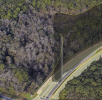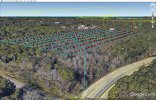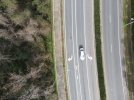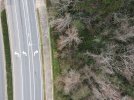As a wildlife rehabilitator, as an everyday job for the past 16 years, and also using drones as part of that job, this absolutely looks like a raptor attack to me. I've had collisions with angry birds and even the top of a lamp post in the past, and they looked just like this. In two cases, with a complete horizontal roll before the drone recovered. Fortunately, each time I was able to land, but there was prop damage, sometimes loss of as much as 1/4 of one prop. Of course this is conjecture unless and until the drone is found, and I can offer nothing on actually locating the drone, but I find collision with a bird to be more plausible than momentary electronics failure and then momentary recovery from that failure. I offer this more so as informational for the future and to warn other drone operators. You were flying above a busy road over a heavily wooded area. And about the right altitude for a soaring raptor to have been scanning. And raptors would hunt above such a road, watching for easy road kill carcasses that are sure to be plentiful alongside any busy roadway through a heavily wooded area. They're intelligent and know where to find easy meals that they didn't have to kill themselves. But I strongly suspect that parking your drone momentarily in the sky above what would be an area highly observed by raptors, looked like an easy opportunity to catch a slow moving "bird", and the raptor is most likely to have struck from behind in that case, as is their customary way when taking another bird in the air for prey. Drone operators should always be mindful that certain areas are patrolled more heavily by raptors for certain reasons, and that being stationary or slow will make your drone a more inviting target. There's little you can do about it to prevent it in most cases, but being aware and always scanning the rest of the airspace periodically for such conflicts may be enough to avoid a costly mistaken identity by wildlife. Also, for this very reason, I now run strobes on my Mavic, even in daylight, as one way to mitigate possible attack from a raptor is the disorienting effect a strobe would have on their vision as they approached closer. They are more likely to "wave off" the attack before making contact if you employ top side strobes. Since utilizing strobes in day flying, I have not had any more collisions or close approaches from birds, either territorial aggression, nor attempted predation. And if the drone goes down, it's also just a lot easier to visually track it or locate it after the crash with another drone in an aerial search if you have independently powered strobes on board that could continue to operate for a number of hours. There's no downside I can see to running strobes also in daylight, as long as they're placed far enough outside of the camera view.















